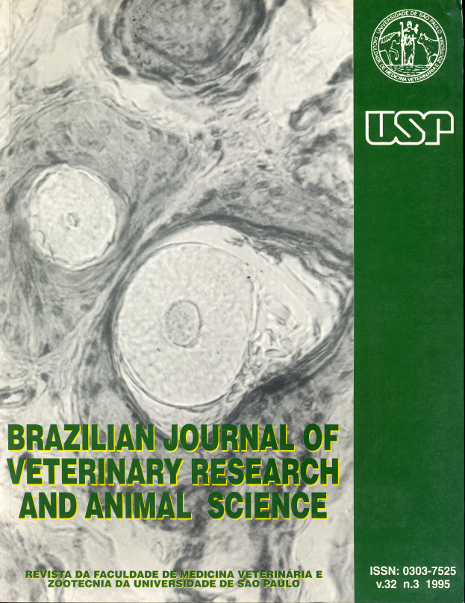Effect of salinomycin and tiamulin association in broiler chicken diets
DOI:
https://doi.org/10.11606/issn.1678-4456.bjvras.1994.52104Keywords:
Nutrition, Poisoning, Tiamulin, Salinomycin, Broiler flowl, AntibioticsAbstract
A seven week floor pen trial in boxes (1,8 x 1,7 m) were conducted with 648 male and 648 female commercial Ross broilers to determine the effects of association of constant level (60 ppm) of Salinomycin and six levels (0; 10; 15; 20; 30 and 40 ppm) of Tiamulin, in six replications of 36 birds each. The rations for all treatments from 1-11, 12-23, 24-44 and 45-49 days attended the needs according to the NRC-1984 specification. All drugs were withdrawn for the four days pryor to slaughter. Body weights, feed intake and efficiency were recorded at 23 and 49 days of age. Mortality was determined at 49 days of age. When chickens were 1, 35 and 45 days old eighteen birds from each treatment were randomly collected and tested sorologically for Mycoplasma sp. At this same age six birds from each treatment were taked randomly necropsied and submited to score evaluation for macro and microscopic lesions. The differences among treatments were not statistically significant (P>0.05) for any paramethers studies and with the following means: Body weight at 23 days (797.9 g) and 49 days (2,247.0 g). Average daily weight gain (45.0 g). Feed consumption 23 days (1,164 g) and 49 days (4,321 g). Feed efficiency 23 days (1.45) and 49 days (1.92) and mortality 49 days (6.7%). All samples presented no lesions and were negative for Mycoplasma galissepticum rapid soroaglulination. No detrimental effects were observed in broiler performance due to the association of salinomycin (60 ppm) and tiamulin (10 a 40 ppm).
Downloads
Downloads
Published
Issue
Section
License
The journal content is authorized under the Creative Commons BY-NC-SA license (summary of the license: https://





